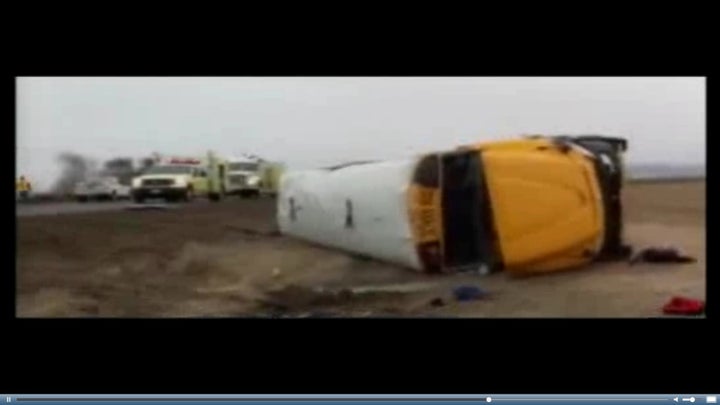
Three separate school bus accidents on Monday - in Indiana, Washington State, and Ohio -- have left a student and a bus driver dead, and scores of students injured, some critically. The three crashes have fueled concerns about school bus safety.
In the Indiana accident, the bus was mangled when the driver hit an overpass without braking. In Washington, the bus rolled over after it veered off the road. In Ohio, the bus tipped and then rolled over onto its right side into a ditch.
None "of the buses were equipped with passenger seatbelts, which the National Highway Traffic Safety Administration (NHTSA) does not require in larger school buses." But those accidents have now renewed calls for passenger seat belts on all school buses.
Federal law requires seat belts on school buses weighing less than 10,000 pounds, but 80 percent of the nation's school buses do not fall into this category. Six states -- New York, New Jersey, California, Florida, Texas and Louisiana -- have laws requiring seat belts on all school buses. But just because seat belts are installed, doesn't guarantee they will be used.
For example, New York leaves the decision of whether the seat belts will be used to local school boards. On the contrary, the Texas law calls for disciplinary action against students who do not use them. California and Florida laws, while requiring seat belts in school buses, state that employees of school districts are not responsible for requiring students to buckle up.
The debate about seat belts on school buses has been going on for years. Despite increasingly strict requirements about helmets for bikers, seat and lap belts, and car and booster seats for children in passenger vehicles, school bus safety has not kept pace. In an ABC News interview, NHTSA spokesperson Lynda Tran said of school buses: "They are safer than their parents' cars." But Dr. Phyllis Agran, a pediatrician, told ABC that about 17,000 children are treated in emergency rooms each year from injuries sustained in school bus injuries.
Defenders of the status quo regarding school bus safety contend that statistics are on the side of the 24 million children who take a bus to school each day. But statistics fly out the window if it is your child who is involved in an accident.
Two of my three children were involved in school bus accidents and I have to tell you that although they were minor, it was a chilling experience to be notified that your child has been in a school bus accident. Parents have a right to expect that when they put their children on the school bus in the morning, they will get to and from school safely. They certainly don't expect serious injuries or worse.
Seat belts have become a hot topic, but I can tell you as a former school administrator that they are not the only bus safety issues. Buses tend to be a "no man's land" when it comes to supervision. It's difficult for drivers to steer the bus while at the same time police kids' behavior. Because there is no adult supervision on the bus other than the driver, school buses are fertile fields for bullying, profanity, fistfights, and other dangerous behavior, such as walking around while the bus is in motion and throwing things.
- Kids should go directly to their seats. They should remain seated and facing forward for the entire ride.
- Children should speak quietly and make every effort not to distract the driver.
- Students should not throw things on the bus or out the windows, or play with the emergency exits.
- The aisles of the bus should be clear at all times. That means no walking around or placing objects that may cause someone to trip.
- In an emergency, children must listen to the driver and follow instructions.
- Students should never put head, arms or hands out of the window.
- At their stop, children should wait for the bus to come to a complete stop before getting up. They should then walk, not run, to the front door and then exit using the handrail.
Visit Your Education Doctor: www.youreducationdoctor.wordpress.com